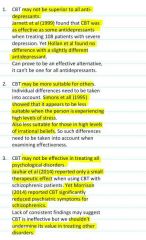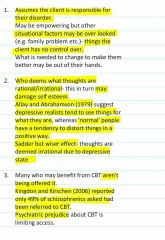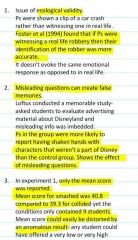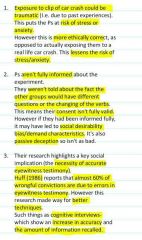![]()
![]()
![]()
Use LEFT and RIGHT arrow keys to navigate between flashcards;
Use UP and DOWN arrow keys to flip the card;
H to show hint;
A reads text to speech;
12 Cards in this Set
- Front
- Back
- 3rd side (hint)
|
Computer Analogy |
Input- how we take in info. Process- how we store it Output- recall when necessary During this process we use cognitive processes of perceotion, attention and memory- I.e. the pocess of a computer's software. |
The human mind is like a computer. |
|
|
Internal Mental Processes |
Where essential cognitive processes all work together to help us make sense of (and respond) to the world around us. We pay attention to it, perceive its features and search through our memory to match it with something we've already seen/experienced. |
Sees humans as information processors. Mental processors work together to allow us to respond- I.e. information process. |
|
|
Schemas |
Built up through experiences and stored in our long term memory. Can be refined through further interactions with people/environment. |
Organised packets of information. Often built up through social exchange- so may not represent reality. |
|
|
Formation of Relationships |
Internal Mental Processes Self perception & perception of others can determine our desire to enter a relationship or not. Memory also is important, as if we have positive past experiences as opposed to negative ones- it affects our drive to forming relationships.
Schemas May govern how we feel and act towards people. Dian et all (1972) came up with the halo effect- people who are physically attractive are associated with positive traits. Self schemas- matching hypothesis (how we perveive our own attractiveness influences who we engage with). |
Mother & Infants Pet & Owner |
|
|
Cognitive Behavioural Therapy |
1) Talk about potential concerns/symptoms of concern. 2) Discuss any natural coping strategies. 3) Psycho education- de catastrophises and normalises experience of symptoms, increases understanding of context, therapist assesses understanding further. 4) Cognitive therapy- verbal challenges and behavioural experiments used to address positive symptoms. Helped to distinguish thoughts and feeling. Then challened to think differently- possible different views (asked to keep a diary). 5) Behavioural Skills Training- relaxation, scheduling, distraction and problem solving. 6) Relapse Prevention Strategies- identify early warning indicators of relapse and develop plans in what to do in such a case. |
Cognitive element. Behavioural element. |
|
|
Cognitive Behavioural Therapy- Effectiveness |

|
|
|
|
Cognitive Behavioural Therapy- Ethics |

|
|
|
|
Loftus & Palmer- Characteristics |
Experiment. Laboratory. Questionnaire.
Experiment 1- 45 students, shown 7 different traffic accidents. Experiment 2- 150 students, shown a clip of a multiple car crush. |
Findings Ps estimated fastest speed when verb smashed was used and slowest when verb contacted was used. Conclusions Indicate that the form of a question can sydtenically affect answers. |
|
|
Loftus & Palmer- Procedures & Findings (Ex 1) |

1) 45 students. 2) 7 films of a traffic accident were shown. 3) Received a questionnaire- 'give and account of what you see'. 4) Ps divided into 5 groups of 9 Ps. Each group was given a slightly different specific question. 5) Ps estimate speed in miles per hour. |
|
|
|
Loftus & Palmer- Findings & Conclusions (Ex 2) |

1) 150 Ps were shown a film of a multiple car crash. 2) 50 Ps asked with the verb smashed. 3) 50 Ps asked with verb hit. 3) Final 50 Ps were not exposed to any question. 4) 1 week later, Ps returned and answered questions. 5) Critical question was 'did you see any broken glass?' |
Findings When verb smashed was used, twice as many Ps reported seeing broken glass than the use of control. Conclusion Leading questions can distort a witnesses' memory of an event and even a small change had an effect. |
|
|
Evaluating- Findings & Conclusions |

|
|
|
|
Evaluating- Ethical Issues & Social Implications |

|
|

